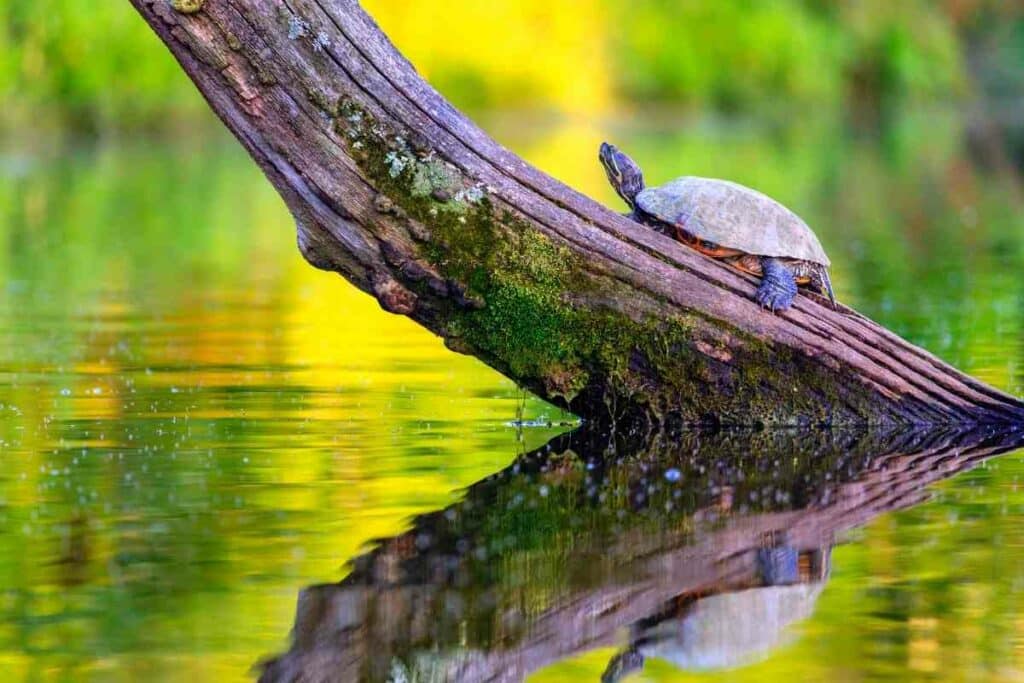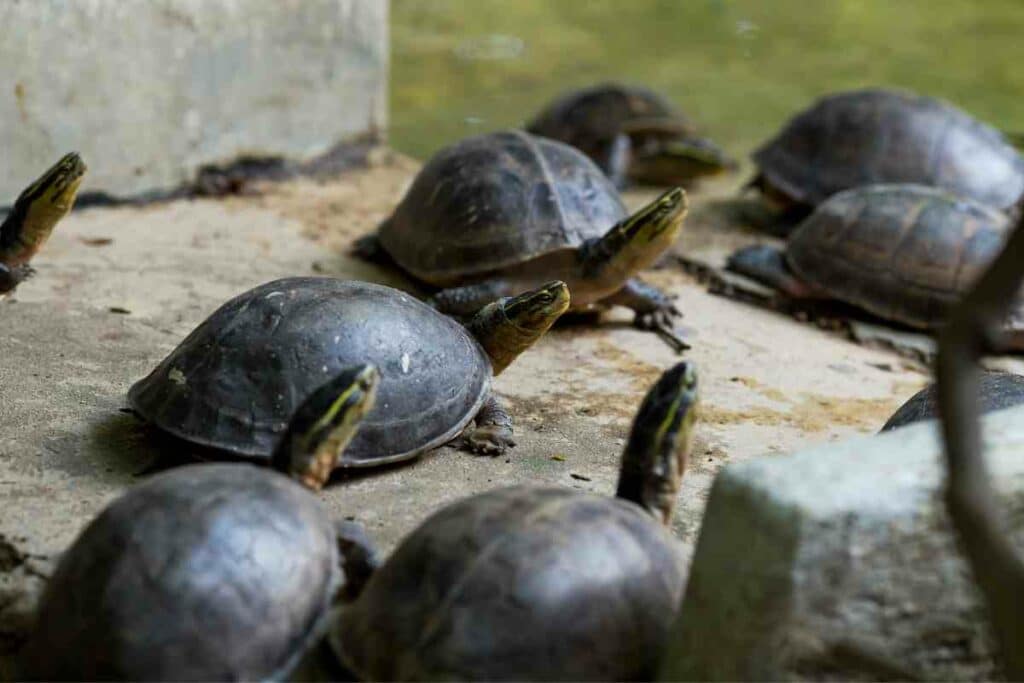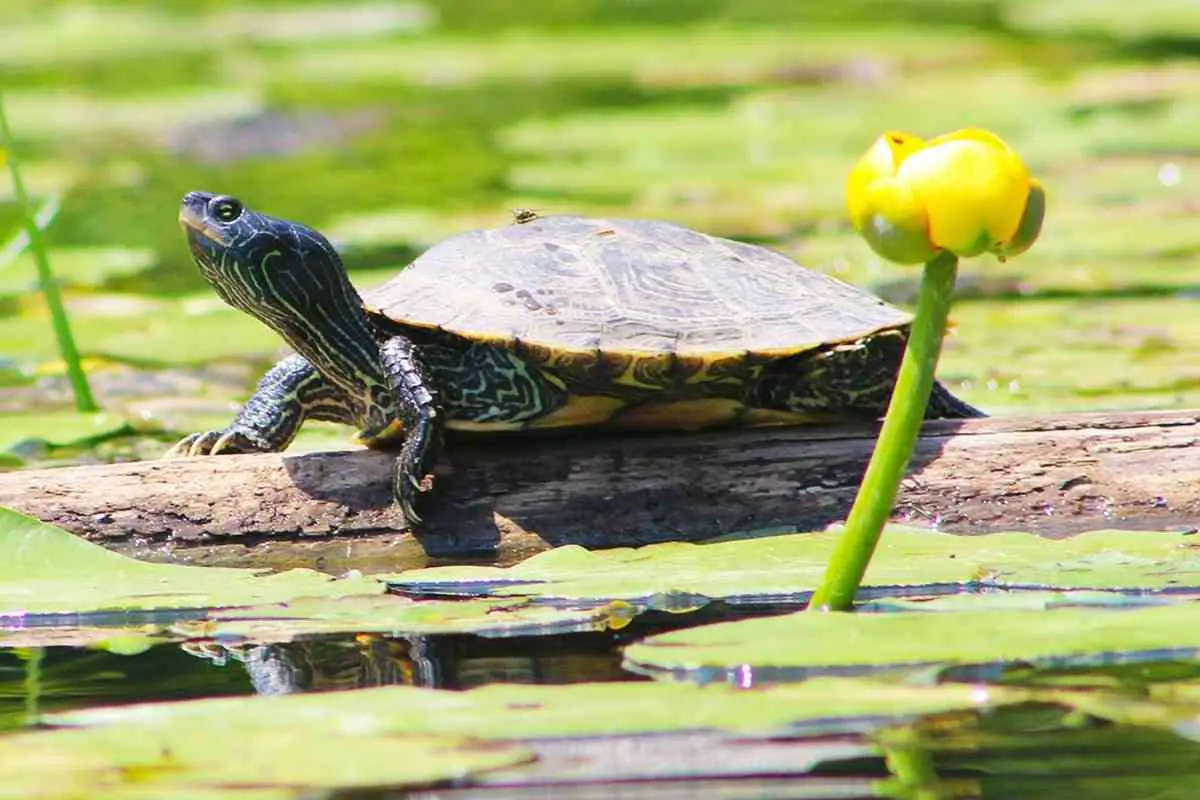To keep turtles in a backyard pond, you’ll need to make sure that the pond is in the proper location, that it’s the right depth, that it has sun-basking areas, and that it’s easy for a turtle to enter (via sloped sides). What’s more, you will most often need to provide protection from predators in the form of a fence. There are also certain plants that will attract turtles, and encourage them to stay in your backyard pond.
Learn more below!
What Turtles Can Potentially Live in a Backyard Pond? (A Bit About Each)

Painted-Turtle
Painted turtles are some of the most popular pet turtles.
They have smooth, green to black shells that look as if they’ve been lightly painted in red and yellow!
They live in:
- lakes
- ponds
- marshes
- or other slow-moving water (such as rivers)
Painted turtles are incredibly common, and as such, they’re some of the most likely to move to your pond.
They eat plants, insects, and small animals (like minnows or crabs).
Keep in mind, painted turtles are hunted by otters, raccoons, minks, foxes, and more. Water is their sanctuary.
Be Creative: If you wish to attract a painted turtle to your backyard pond, you’ll want to make sure the pond provides plenty of spaces for them to hide from any predator!
Red-Eared Slider
Red-eared sliders are named for the red, paint-like marks they sport behind each ear.
They are small, sleek turtles. They’re a dark, olive-green, color, providing a lovely contrast to those red marks.
Red-eared sliders are some of the most popular sliders in the pet trade. Unfortunately, this has led to many being released into the wild.

Still, as a result, you have a pretty decent chance of attracting one to your backyard pond.
Red-eared sliders have curious, intelligent personalities and are only a foot or less in length.
Finally, red-eared sliders will require plenty of sunny spots, as they love to sun bask!
Box Turtle
Box turtles are small turtles, measuring an average of 4-6 inches.
They have ridged shells, much like a tortoise. These furrows deepen with age.
In the wild, box turtles can be found around:
- marshes
- ponds
- forests
- or slow-moving rivers
They are brown, with subspecies that are yellow-brown, all with yellow markings to be found on their shell.

Box turtles like it warm, but not hot. In excessively hot weather, they will retreat underwater or into shaded spots nearby.
If you’re hoping to attract box turtles, you’ll need to make sure there are plenty of places for them to cool off.
On cool days, on the other hand, they may be seen to sun bask!
Common Map Turtle
Among map turtles, the males are smaller (about 6-inches) and the females are larger (up to 10.5-inches).
How did they get their name?
Common map turtles have olive-green shells, decorated with intricate yellow lines that can be said to resemble a map.

Hence, the name ‘map turtle,’ came to be. Unlike most turtles, common map turtles are okay with running water (within reason) and can be found not just by ponds, but also near rivers.
They spend most of their day hunting, primarily for insects.
To attract a common map turtle, you’ll want to provide plenty of sunny spots, as they also love to bask!
Know Your Hardiness Zone
One of the most important things to consider when it comes to attracting turtles is your hardiness zone.
If it’s the wrong hardiness zone, you run the risk that they will freeze. Typically, the recommended zone for turtles is no less than 7.
This will ensure the most comfort for a variety of turtles (such as those listed above).
Any colder, and you’ll have to keep them indoors, or at least bring them in for the winter!
Choose the Proper Pond Depth
Turtles like ponds with deep parts, and shallow parts, as well as parts completely out of the water.

They use the deep parts of the water to hide and cool off, and the shallow places to lay eggs or bask!
Ideally: Your backyard pond should provide both deep and shallow areas. This can be done when you’re planning out the pond (as detailed below).
Avoid Placing the Pond Under a Tree
If you’re looking to provide shade (or simply for the sake of beauty), you may be considering placing your pond under a tree.
Actually, falling leaves can be a real issue for pond wildlife. They will quickly rot, making the pond itself dirtier.
Instead, if you’re looking to create shade, it’s better to use an umbrella. Remember that the pond will need sunlight in order to support plants, however!
Partial shade is ideal. This way, the turtles will also be able to warm up and sun bask!
Basking Area (Sunlight)
Just about any turtle will require and appreciate a basking area.
These are places in a pond that stick out above the water, staying dry.
They heat up in the sunlight, creating a perfect place for a chilled turtle to bask!

You can create these basking areas easily, with a few tall, flat-topped stones (their favorite), a log, or something similar.
Depending on the turtle, they may spend a good portion of their daying warming up in this special basking area. It’s an endearing sight.
Just don’t forget to include shaded spots, too, and your turtles will be even happier!
Plants (Certain Kinds)
Some of the main things that will attract turtles to your garden are plants.
Turtles primarily eat insects but may take a bite out of some plants.
Overall, the plants will provide cover and make the area more pleasant for your turtle visitors.

For instance, you can plant wildflowers around the outside of your pond.
Inside your pond, you can try some of their favorites:
- water ferns
- black cohosh
- fairy moss
- waterweed
- duckweed
- water lettuce
- and water hyacinth
Another pro-tip is to plant a fruiting bush nearby.
It’s true that turtles prefer insects, but they also consider certain plants and fruit a tasty snack!
Security
Opposoms, dogs, cats, raccoons, moles, rats, and even certain birds may all consider your turtles for a snack.
With this in mind, it’s super-important that you put an emphasis on pond security.
There are a few things that you can do to make your outdoor turtle habitat safer:
- First off, consider the size of your pond. A small pond makes it harder for turtles to dive deep and hide.
- It is much easier to completely fence off, however! Netting or chicken wire should work!
Just a few feet of chicken wire around the edges is ideal, and if your pond is small enough, you can put some above it (a few feet up).
When it comes to keeping out a variety of predators, this should do the trick!
How to Build a Turtle Pond Yourself

1. Map Out the Pond/Excavate It
The first step to building a turtle pond is to map the pond out.
Make sure that all of the sides are even so that the water won’t spillover.
You can also dig out various depths along the edges, including both shallow areas and deeper areas.
This will ensure that your turtles have places to hide and places to bask! If you have a premade pond, this can also work.
Just keep in mind that you won’t have as much creative freedom. For a premade pond, simply dig according to the size and shape of the premade-pond.
Keep In Mind: The trade-off is that – even though they’re not detailed – installing a premade pond can be easier. It all depends on what you’re looking for!
2. Make Sure the Sides Are Sloped
While you’re designing or picking out your backyard pond shape, remember that turtles will appreciate a slope.
Otherwise, it can be too difficult for them to enter the pond gracefully. As such, they may decide to go elsewhere.
If you’re hoping to attract turtles, sloped edges just might do the trick!
3. Choose the Ideal Depth
The Best Depth for a Turtle Pond is 1-2.5 deep.

We recommend closer to 2-5 feet deep if you can manage it. This will ensure that there are plenty of places in the water where your turtles can hide from predators.
Not only that, but deeper water freezes more slowly and – ideally – leaves places that are still liquid.
This will help your turtle friends stick around simply by diving deep, and enables them to survive the cold of winter!
4. Provide a Protective Wall
As touched on above, any great turtle pond should have some manner of wall around it.
This will help keep predators out and encourage turtles to stick around.
A close-slotted fence or log wall should work!
Final Thoughts
So, if you were wondering how to keep turtles in a backyard pond, you have your answer.
First, you’ll need to properly map out your design, or simply dig out the shape of a premade pond (which you choose).
Ideally, this should contain both shallow areas and deep areas. This will ensure places to hide, as well as places to sun bask.
Additionally, turtles will appreciate plant cover in the pond (such as water lettuce).
You can even plant a fruiting bush nearby, to sweeten the deal.
Best of luck!
